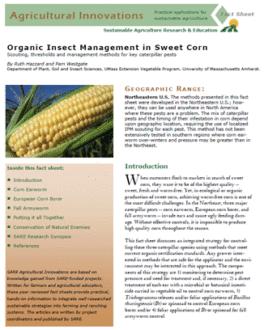Depending upon location and the time of the season, it is possible to have one, two or three of the key caterpillar pests in a single planting of sweet corn. European corn borer and fall armyworm may be feeding at the whorl or tassel stage and can move into ears during silking. Some enter ears through the tips and some through the side. Corn earworm enters only through the tip, and only during silking. An integrated strategy is needed to address each pest, at the appropriate growth stage of the corn.
The following approach has provided effective control of all of these pests in experimental trials in Massachusetts (see Table 1):
Whorl stage: Scout for fall armyworm. If infestation is greater than 15%, spray with Bt or spinosad. If using Trichogramma, start releases at this stage.
Pretassel/tassel stage: Scout for European corn borer and fall armyworm. If infestation is greater than 15%, make a foliar application of Bt or spinosad; scout and make a second application, if needed, five to seven days later.
Early silk stage: If corn earworm moths are present, use the oil method to control all caterpillars that enter through the tip. If European corn borer flight is high during silking, apply Bt or spinosad.
| Table 1. Recommended treatments for each caterpillar pest. | |||
| Pest | Oil Treatment | Foliar Spray | Trichogramma release |
| Corn earworm(CEW) |
X
|
X**
|
.
|
| European corn borer (ECB) |
X*
|
X
|
X
|
| Fall armyworm (FAW) |
.
|
X
|
.
|
| *Oil reduces damage that results from any caterpillars that enter through the ear tip, including ECB; other methods are needed to achieve integrated control of ECB. **Spinosad only; not Bt; suppresses CEW only if used in intensive spray program. |
|||
